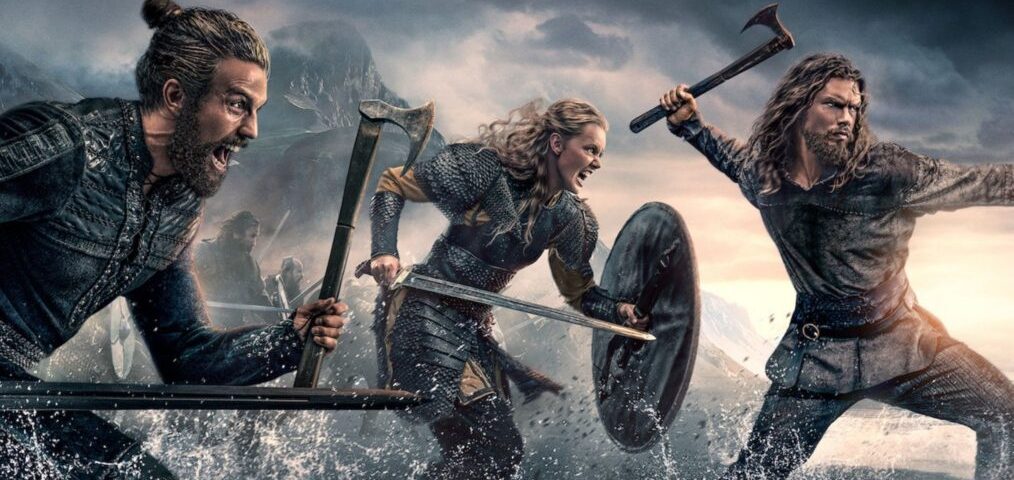
E34.5 – Ridley Scott’s “NAPOLEON” (2023) – Movie Review (Podcast)
December 4, 2023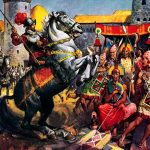
PIZARRO: Fall of the Incan Empire
January 15, 2024Our saga continues with even more totally berserk Viking warriors! Last time we talked about the early sagas of the ‘Viking Age’ with Ragnar “Harry Breeches” Lodbrok, the epic legend of Lagertha, Björn Ironside, Ivar the Boneless, Harald Fairhair, the bloody tale of Erik ‘Bloodaxe’ Haraldsson, and the terrifying Gunnhild, Mother of Kings! (Check out my previous article on 7 of the most insane Viking Sagas ever! )
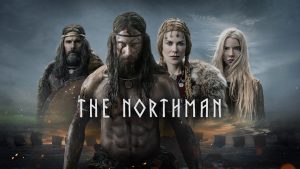
What we often refer to as “the Vikings” was actually a diverse group of Scandinavian cultures originating in Norway, Sweden, and Denmark. Many other cultures referred to them as ‘Norsemen’ or ‘The Northmen’. They were known for their seafaring expertise, their epic combat skills, and their larger-than-life myths went on to inspire the likes of Tolkien and Marvel comics. They were feared by several nations for their raiding parties, eventually conquering several kingdoms, they ‘discovered’ North America (a good five centuries *before* Columbus), and these battle-hardened warriors would ultimately change the course of European history forever!
8. Rollo the Dane – Ruler of Normandy

While the legendary Norse warrior known as “Rollo” would go on to become one of the most successful rulers of the Viking era, much of his past is still shrouded in mystery, presumably because no one bothered to write anything down back then. Historians speculate that he was born around the 860’s and was either from Denmark or Norway. The name ‘Rollo’ was most likely originally Hrólfr or ‘Rolf’ – which was short for ‘Rudolph’ (Hrodwulf), which in Old Norse basically means “Renowned Wolf”, but that was too hard for the French to pronounce, so they just started calling him Rollo, I guess. He is also sometimes referred to as “Rolf the Ganger” or “Rollo the Dane”.

It is said that Rollo lead several raids against Frankish settlements in what is now northern France, including two separate sieges on Paris in 876 and 886, which were fended off by Count Odo of France. Eventually, the Franks got kinda tired of all the sacking, looting, pillaging, and murdering, so the King of West Frankia, Charles the Third aka “Charles the Simple” (not to be confused with the other Charles III, “Charles the Fat” – who also ruled France), started to bribe the Viking invaders with silver to please stop attacking them constantly.
In the year 911, Charles the Simple made a deal with Rollo (after yet another failed siege attempt). King Charles would grant Rollo the lands of northern France (between the mouth of the Seine River and Rouen) for his people to settle *IF* he were to swear allegiance, convert to Christianity, and help defend against other Viking raiders. To sweeten the deal, he even threw in the chance to marry his daughter, Princess Gisela. Rollo accepted the deal, becoming the first (unofficial) Duke of Normandy.
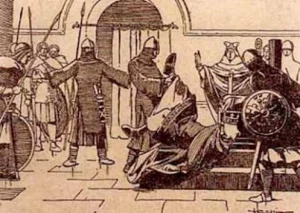
One of the earliest historical records of Rollo is actually from the year 918, a charter signed by Charles III referring to a grant to “Rollo and his associates” for “the protection of the kingdom”. Apparently, during the treaty ceremony, Rollo was urged by the Bishop to kiss the King’s foot, proving his allegiance, but Rollo refused, “I will never bow my knees at the knees of any man, and no man’s foot will I kiss.” Instead, Rollo commanded one of his men to kiss the King’s foot for him. What happened next reads like a bad SNL skit: Rollo’s warrior did so by grabbing the King’s foot and lifting it to his mouth, causing the King to topple over backward! After everyone stopped laughing, Rollo took a solemn oath of fealty, and swore his allegiance to King Charles.
As the Count of Rouen, Rollo reigned over the flourishing settlements of what soon became known as “Normandy” for the next couple decades, successfully fighting off other Viking lords, and remaining loyal to Charles till the end. Rollo died sometime between 928 and 933, no one’s really sure, but his son, William Longsword, ruled the region from 928 until his assassination in 942, while Rollo’s grandson, Richard the Fearless, ruled Normandy until 996.
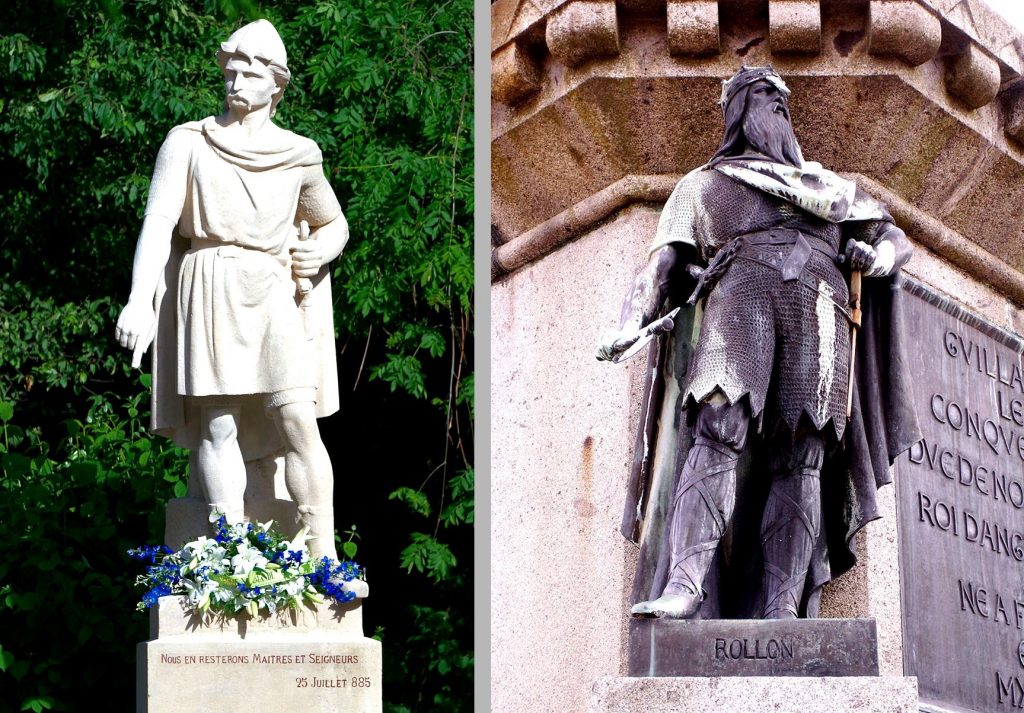
9. Saint Olga of Kiev
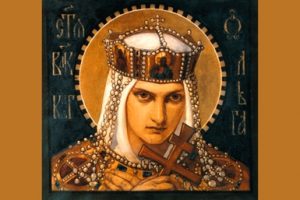
In what is now modern-day Ukraine, the Scandinavian people established rule over the Slavic Tribes of Eastern Europe in the 9th and 10th centuries and eventually became known as the ‘Rus’ – which in Old Norse means ‘the men who row’. (Depending on the source, it may also have come from an Arabic phrase referring to their red hair?)

In the year 862, a legendary Varangian chieftain called Rurik was invited to rule over Novgorod. His successor, Prince Oleg the Prophet captured the city of Kiev and established it as their new capitol in 882, founding the Kievan-Rus nation, before Rurik’s son, Igor came to power in 912 CE. Somewhat ironically (given recent geopolitical events with the Ukrainian / Russian War), the Kievan-Rus of Ukraine would go on to give the Russian people their name.
After inheriting the throne, Igor Rurikovich married a young woman named Olga. Unfortunately, like so many historical women of that era, we don’t know much about her prior to that (thanks to the patriarchy), but she was believed to have been born sometime between the years 890 and 925. According to some Russian historians, she was just 15 years old when she became the Queen of Kiev. What we do know for certain is that she gave birth to her son, Sviatoslav in 943. (More on all that in a bit.)
Following the death of “Oleg the Wise”, a Slavic tribe called the Drevlians stopped paying tribute to the Rus and instead began supporting a rival warlord. Igor of Kiev wasn’t too happy about this, and decided to pay them a visit in 945 – with an army behind him. The Drevlians begrudgingly conceded and paid up, but (unlike Oleg) there’s a reason this Kievan Viking wasn’t known as “Igor the Wise”, because he completely and totally failed to read the room. Igor got greedy and decided to up the rent on the Drevlians, but when he returned to collect, he got more than he bargained for – according to Leo the Deacon, Igor was “captured by them, tied to tree trunks, and torn in two.”
Back home in Kiev, Igor’s widow became the new Regent Queen, because the heir to the throne was still 3-years-old. Now, as if murdering the Queen’s husband wasn’t bad enough, the Drevlians then had the nerve to send a messenger to tell her that she should consider marrying their leader, Prince Mal – the guy who just killed the father of her son! Like Uma Thurman in “Kill Bill”, Olga chose revenge instead…

The Patron Saint of bloody vengeance…
Olga’s response to this brazen insult however, surprised them: “Your proposal is pleasing to me. Indeed, my husband cannot rise again from the dead. But I desire to honor you tomorrow in the presence of my people. Return now to your boat and remain there with an aspect of arrogance. I shall send for you on the morrow.”
Without giving it a seconds thought, the Drevlian delegation returned to their boat as instructed. The Kievan-Rus ‘honored’ them by lifting them in their boat and carrying them through the streets. They didn’t realize they were being carried to their deaths until it was too late. Olga’s men had spent the night digging a large trench, which they then flung the Drevlian ambassadors into – burying them alive! (with their boat) As the men were begging for mercy, struggling to breathe, the Queen asked them, “Is this honor to your taste?”
Olga was just getting started…
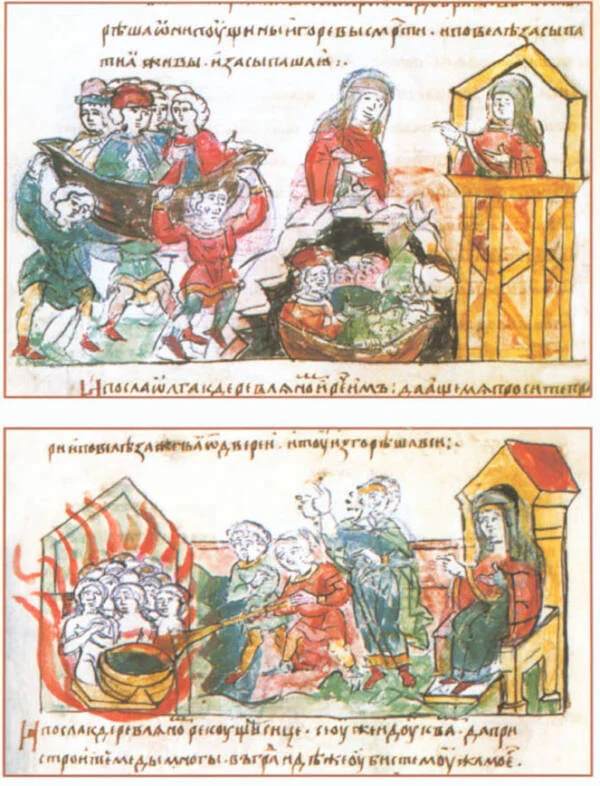
While the first delegation was being “dealt with”, she sent an embassy to Prince Mal, accepting his “proposal”. After presumably picking his jaw up from the ground, Mal and his men immediately rode for Kiev. When their party arrived, Queen Olga was there to greet them, and offered to have her people draw baths for them, after their long journey. The dim-witted Prince fell for it, of course, and the VIP’s were lead to the royal bathhouse – where they were locked inside and burned alive!

Before word got out about the assassination of their Prince, Olga sent *another* message to the Drevlians: “Prepare great quantities of mead in the city where you killed my husband, that I may weep over his grave and hold a funeral feast for him.” Without suspecting a thing, the Drevlian villagers did as she asked. By the time she and her army arrived for the festival, half the town was drunk, which made them a lot easier to massacre. After slaughtered 5,000 men, women, and children, she then set her sights on all the remaining Drevlian settlements in the region. She wasn’t just content with sending a message, she was determined to wipe them off the face of the Earth!

Like the Klingon proverb says, “Revenge is a dish best served cold.”
It all came down to the Siege of Iskorosten (known today as the city of Korosten in Ukraine), where the remaining Drevlians made a desperate last stand. She wrote to them with a letter offering peace if only they surrendered, “Why do you persist in holding out? All your cities have surrendered to me and submitted to tribute, so that the inhabitants now cultivate their fields and their lands in peace. But you would rather tide of hunger, without submitting to tribute.”
This time, the Drevlians refused to lay down their arms, believing (rightly) that she would simply kill them. In response she assured them that she would not attack, and asked for just 3 sparrows and 3 pigeons from every house as a show of good faith, writing, “I do not desire to impose a heavy tribute, like my husband, but I require only this small gift from you, for you are impoverished by the siege.” The remaining Drevlians were suspicious, but eventually did as she asked…

*Maniacal Laugh*
According to the Chronicles: after tricking them with her false offer of peace, the blood-thirsty queen had the birds gathered up, tying sulphurous cloths to each of their legs before setting them on fire, then releasing them towards the town, which set the whole town ablaze! “There was not a house that was not consumed, and it was impossible to extinguish the flames, because all the houses caught fire at once.” She then ordered her soldiers to catch everyone who fled from the burning city – anyone who didn’t resist was taken into slavery, and those that survived the fire, were then forced to pay tribute.
Oh, did I mention she was a Saint?
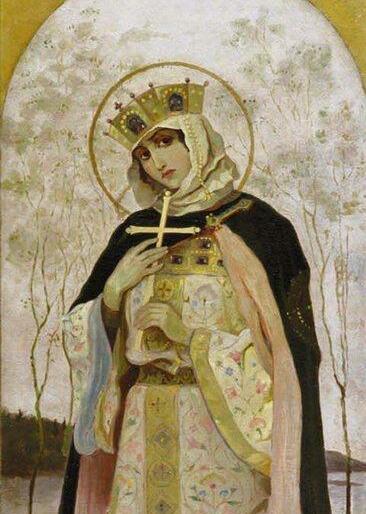
Who, me?
That’s right, despite being a cold-blooded Queen who only ‘converted’ to Christianity as a political tactic, “Saint Olga” was venerated by the Eastern-Orthodox Church in 1574 (possibly even as early as 1284), as the saint for ‘widows’ and ‘converts’ – for being one of the first Viking rulers (in the region) to be baptized. The Byzantine Chronicle recorded: “She shone like the moon by night, and she was radiant among the infidels like a pearl in the mire, since the people were soiled, and not yet purified of their sin by holy baptism.” She is still considered to be “Equal to the Apostles” to this day!
After traveling to Constantinople and making an alliance with the Byzantine Emperor in 957, Olga was baptized and changed her name to Helen. Once he was old enough, Sviatoslave, took the throne in 963, but she remained a powerful regent in Kiev until her passing in 969. For all her terrible deeds, her son was able to grow up in this brutal world, thanks in part to her barbaric schemes. Some may question the morality of her actions, but there is no doubt that they were ultimately motivated by love, like a deadly mamma bear protecting its cubs…

Vladimir the Great, Olga’s grandson (one of the surviving sons of Sviatoslav the Brave), eventually consolidated power in the region, and made an alliance with the Eastern-Orthodox Church and Constantinople, marrying Princess Anna, the sister of the Byzantium Emperor (Basil II), and eventually converted to Christianity in 988, shortly before his death. Vladimir’s son, Yaroslav the Wise, took the throne as the Grand Prince of Kiev and led the region into an era of prosperity. The Kievan Rus remained a formidable power in the region until The Crusades, which shook up Medieval power structures across Europe, prior to being conquered by the Mongols in the 13th Century.
In more recent years, the legends of Saint Olga’s revenge have been embraced by the people of Ukraine as a symbol of resistance, and a warning to their adversaries. In 2022, during Putin’s attempted invasion of Ukraine, women would walk up to Russian soldiers, handing them sunflower seeds to put in their pockets so that “they would grow on Ukrainian land, after they died…”
10. Egill Skallagrímsson
Egil Skallagrimsson (Ska-La-Grim-Son?) was a “Viking poet” – seriously! (And no, that’s not an oxymoron.)
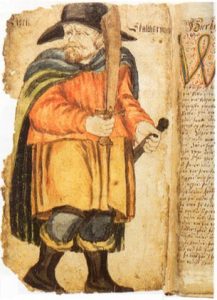
You might think of a stereotypical Viking as a Berserker foaming at the mouth with an axe in one hand and a filled with mead in the other, that doesn’t mean they were (all) illiterate meat-heads. While it’s true that most of what we know about them comes from other cultures of the time, that doesn’t mean they were without their own culture and written language. They had an alphabet made of runes used for ceremonial purposes. Many of the sagas from their history were passed down through oral tradition… that is until this guy named Egil came along and realized that someone should have been writing all this stuff down all along!
Egil Skallagrimsson was born around 904 CE, in “Iceland” – which was first discovered by Viking explorers, and later settled by a guy called Floki (full name: Hrafna-Flóki Vilgerðarson), who named it after all the icebergs. Egil’s father was Skalla-Grímr Kveldúlfsson (yeah, there’s a lot of hard to pronounce names here), a powerful chieftain who was mortal enemies with Harald “Fairhair” (see Part One). Egil wrote his first poem at the age of 3 and like a good Viking, committed his first murder at just 7 years old! Apparently, one of his friends was caught cheating in a game, so he took an axe to the cranium.
Just because he was a writer doesn’t mean he was laidback, this guy was still very much a Viking! This one time, when his wife (Ásgerðr) was cheated out of her inheritance, he challenged Berg-Önundr to a duel to the death! Berg turned down the challenge, so Egil killed him anyway, then proceeded to kill *both* of his brothers! The last one, Atli the Short, he murdered by *biting through his neck*!

Is it just me, or does this dude look like he’s played by Dwayne ‘The Rock’ Johnson?
According to the sagas, he “was large-featured, broad of forehead, with large eyebrows, a nose not long but very thick, lips wide and long, chin exceeding broad, as was all about the jaws; thick-necked was he, and big-shouldered beyond other men, hard-featured, and grim when angry. He was well-made, more than commonly tall, had hair wolf-gray and thick, but became early bald. He was black-eyed and brown-skinned.”
Skallagrimsson would go on to have an extremely petty rivalry of epic proportions with both Erik Bloodaxe *and* Queen Gunnhild (both of whom we mentioned last time), not only killing several of their family members, including their son for insulting him, but also killing ALL the people they sent after him in revenge, just for good measure. Gunnhild was said to have put a spell on Egil, so he just cursed her right back. Here’s where it gets really strange though: shortly after Erik and Gunnhild fled Norway to the Kingdom of Northumbria (England), where they quickly took over, Egil just so happened to wreck his ship in Northumbria! Egil marched up to the court and came face to face with a room full of enemies…

Egil was given one day to plead his case as to why they shouldn’t execute him on the spot for his many crimes against them, so he went home, stayed up all night writing, composing an epic poem praising his nemesis! Think of it like a one-sided rap battle where Eminem is actually praising his rival at gun point. The dude wrote his heart out and composed an amazing twenty-stanza-long ‘head-ransom’ poem that was chock-full of metaphors, and complex poetic meters! It is said that King Erik was so impressed and moved by Egil’s lyrical rhymes that he decided to spare his life, this time… even though he had murdered their own son!

Despite mending fences with his lifetime rivals, the bard would later go on to side with Gunnhild’s rival, King Athelstan, in the Battle of Brunanburh in 937. Athelstan came out on top and unified the Anglo-Saxon English under one crown. Tragically, Egil’s brother died during the battle, but at least he got two chests chock full of silver for his troubles.
He eventually returned home to Iceland where he became a politician, wrote down a whole bunch more historically-adjacent Viking legends into his eighties, before going blind. He buried his treasure and then killed the servants who helped him bury it, before taking the secret with him to his grave. In fact, he would rack up quite the body count in his lifetime, with some sources claiming the number is about 407!
However, as good as Egil was at killing people, he was an even better poet, and even managed to chill out a guy named “ERIK BLOODAXE” – who was literally known for flying off the handle! As a result, he would go down in history as the most famous Viking ‘war poet’ of the Scandinavian world. I guess the pen really is mightier than the sword?
(But seriously, don’t make fun of this guy’s poems…)
11. Erik the Red
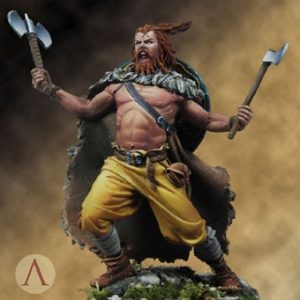
Another infamous Viking named Erik was Erik Thorvaldsson, better known as “Erik the Red” – thanks to his striking red hair, but also possibly reinforced by his ‘fiery temper’… and all the murders that followed it.
Erik (the Red) was born around the year 950. According to the Sagas, Erik’s father, Thorvald Ásvaldsson, was convicted of “some killings”, and the whole family was kicked out of Norway. They were forced to sail west to Iceland, which was actually much more green than the name would have you believe. After the death of his father around 970 CE, Erik got married to a wealthy woman, had some kids, became a farmer, and built a homestead he called “Eiríksstaðir”. Everything was going well at first, but like his father, Erik the Red had a short temper that would end up getting him into trouble, when a series of unfortunate events randomly spiraled out of control…
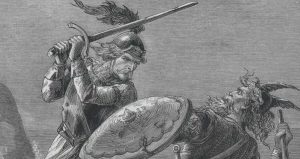
One day, some of his family’s “thralls” (indentured servants or slaves) accidentally caused a rockslide that crushed their neighbor’s house. In retaliation, Eyjolf the Foul (one of the neighbor’s buddies) decided to kill Erik’s thralls, which pissed him off. In a blind rage, Erik stabbed Eyjolf to death with his sword. As a result, a dude called “Hrafn the Dueler” then (as his name suggests) challenged Erik to a duel, so Erik killed that guy too, for good measure.
Now all of that was pretty standard affairs back then, but things really ‘got out of control’ (by Viking standards) when Erik’s *other* neighbor, Thorgest, refused to return some benches that he’d borrowed. Erik, presumably still seeing red, confronted Thorgest about it, who apparently threw a hissy fit. This drove Erik over the edge – he drew his sword and went berserk. When the dust settled: Thorgest, his two adult sons, and “certain other men” (whatever that means) were dead at Erik’s feet. After massacring several more men over a domestic dispute involving chairs, Erik the Red was exiled from Iceland – for just 3 years, which feels like a light sentence.
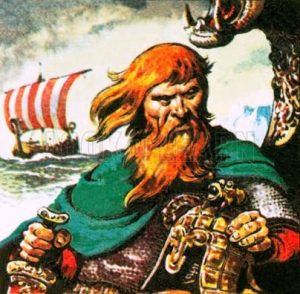
After being banished from both Norway and Iceland, in 982, Erik the Red and his crew set sail to explore a mysterious island, rumored to be further to the west. After sailing for 180 miles, they discovered the rocky, frozen coastline of an uninhabited landmass! Erik spent the next three years of his exile exploring this newly discovered country, naming pretty much everything after himself: the island of Eiriksey (where they spent the first winter), the region of Eiriksholmar (where they huddled up for the second winter), and eventually established the settlement of Eriksfjord. Instead of calling the entire place “Eriksland” though, he decided to rebrand the icey, desolate wasteland as “Greenland” as opposed to “Iceland” (which was already taken anyway), because, in his words “people would be attracted to go there if it had a favorable name”.
With the charming skills of a used-car-salesman, in 985, Erik the Red somehow managed to convince more than 500 unlucky saps to help him settle Greenland. Only 14 of the original 25 ships made it, with 11 being lost at sea. The settlers only found two locations that were barely suitable for farming on the south-west coast, and made the most of it. The Icelanders had traditionally made long-houses from wood, but due to the lack of trees, opted instead to make structures of stone. Despite the harsh conditions, Greenland eventually grew into a thriving fishing community. They even discovered narwhals, the unicorns of the sea!

As the Jarl of Greenland, Erik the Red raised four kids: Freydis, Thorvald, Thorstein, and Leif Erikson – who would also go on to make a name for himself as an explorer (more on that later). After living a peaceful life in his later years, Erik the Red eventually succumbed to illness from an epidemic, during the winter of 1003, shortly after his son set sail for new adventures further west…
12. Sweyn Forkbeard, Son of Bluetooth
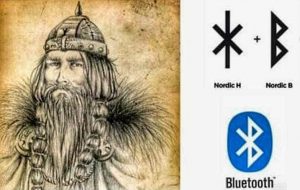
Harald “Bluetooth” (yes, Bluetooth was named after him for some reason) was the son of “Gorm the Old”, brother to Queen Gunnhild, and the reigning King of Denmark. He then (conveniently) became the default King of Norway after the (coincidental?) assassination of his nephew, Harald “Greycloak” (son of Erik Bloodaxe), at the hands of “Haakon the Bad” (not to be confused with “Haakon the Good”, totally different guy). Long story short: Haakon the Bad was declared as Bluetooth’s regent ruler in Norway, which didn’t last long, because he was soon deposed by Olaf ‘Crowbone’ Tryggvason (yet another descendant of King Harald Fairhair). Bluetooth is often credited with introducing Christianity to the Danes, but historians sometimes debate this as apocryphal, because of various conflicting accounts.
Enter: Bluetooth’s son, “Sweyn Forkbeard”.
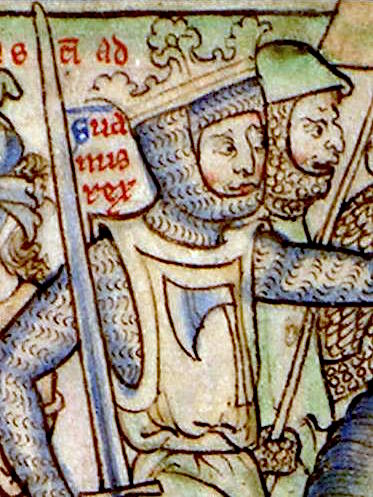
Sweyn (or Svein) is sort of an enigmatic character in history, with a lot of contradictory accounts of his life, but it’s generally accepted that he forcibly dethroned his father, Bluetooth (who died in exile shortly after), to become the new King of Denmark in 986. Although, even his heritage is up for debate, Bluetooth might have actually been his uncle. To make things even more confusing, Sweyn’s mother was either a woman named Tove, or ‘Gunhild’ (not the same as “Gunnhild, Mother of Kings”), and later even married a woman named ‘Gunhild’ (not to be confused with the other two), although she’s sometimes referred to as “Sigrid the Haughty” – who was either the sister of Boleslaus, ruler of Poland, OR the widow of Erik the Victorious, King of Sweden.
Some sources say that Sweyn was a ‘rebellious pagan’ who revolted against Christianity before being banished to Scotland for several years, while others say that he helped to build churches and spread Christianity, but most likely the truth seems to be that he was more open to religious freedom, in letting his people decide their own faith. (Seriously, this is starting to sound like a choose-your-own-adventure book).
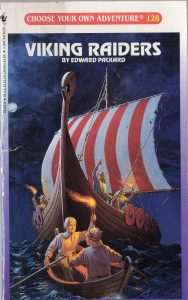
Regardless of whichever head-cannon you ascribe to – after becoming the new King of Denmark, Forkbeard began to consolidate power (as you do) and set his sights on overthrowing the current King of Norway: Olaf Crowbone – another Viking primarily known for brutally forcing his subjects to convert to Christianity or else. According to the (contradictory) Icelandic Sagas, before marrying Sweyn, Sigrid the Haughty was once proposed to by Olaf on the condition that she convert. When she refused, Olaf slapped her in a rage, and Sigrid calmly replied, “That could well cost you your life.”

If that’s not bad enough, Sweyn’s sister, Thyri (aka Tyra of Denmark), married Olaf out of spite (after an unhappy arranged marriage), so he refused to pay her dowry, leading to further animosity. All the while, Sigrid was egging Sweyn on to declare war against his brother-in-law. Everyone was already pretty pissed at Tryggvason for threatening random people with torture unless they were baptized, so Sweyn had no trouble forming an alliance against him. Forkbeard recruited “Olaf the Swede” and Erik / Eiríkr Hakonsson, Earl of Lade and son of Haakon the Bad, who wanted revenge for his father. So yeah, there was plenty of beef to go around.
It all came to a head at The Battle of Svolder in the Western Baltic Sea, around the year 999… or 1000, historians aren’t really sure about that one either, it turns out. Olaf Crowbone was sailing back to Norway aboard his flagship, ‘The Long Serpent’, when they were ambushed by a combined armada of Swedes, Danes, and the Jarls of Lade! Olaf’s fleet was overrun by the Viking rebellion of Sweyn Forkbeard. After being surrounded, instead of being taken alive, Olaf jumped overboard, in full armor, and disappeared beneath the waves…

Like his father before him, Forkbeard was now the King of both Denmark and Norway (after dividing up the territories, much of it ruled by his vassals), but that was just the beginning, because being the King of just 2 countries clearly wasn’t enough, as he then turned his attention towards England…
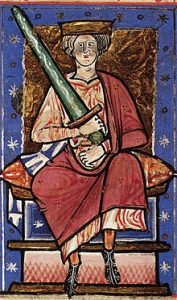
Ethelred the Unready ^
The English King at the time was an ineffectual leader appropriately called Ethelred the Unready. Ethelred II first came into power at the age of 12, after the assassination of his half-brother (which he may have ordered). When the Vikings raided, he first attempted to pay them off with a bribe.
Years later, in 1002, Ethelred ordered a surprise attack on a Danish village in England, known as the Saint Brice Day’s Massacre. When news of the unprovoked attack reached the shores of Norway, King Forkbeard was not too pleased to say the least. After forging an alliance with Duke Richard II of Normandy (France), Sweyn Forkbeard led a series of invasions against England in retaliation against Ethelred’s cowardly actions. During one of the later raids, Forkbeard’s army was led by a legendary Viking called “Thorkell the Tall”.
Unfortunately, in 1013, Thorkell ended up switching sides at the last second and defected into the service of Ethelred (the Unready), along with several other Viking mercenaries. Sweyn, along with his son Cnut (more on him in a bit), personally led his army against Thorkell in London. Although Thorkell and his men successfully held off the initial attack, Ethelred panicked and retreated to Normandy in defeat. Soon after, Sweyn Forkbeard became the first Danish King of England… for about five weeks, until he passed away on February 3rd, 1014 (supposedly after falling off a horse, but even that is up for debate)…
13. Leif Erikson
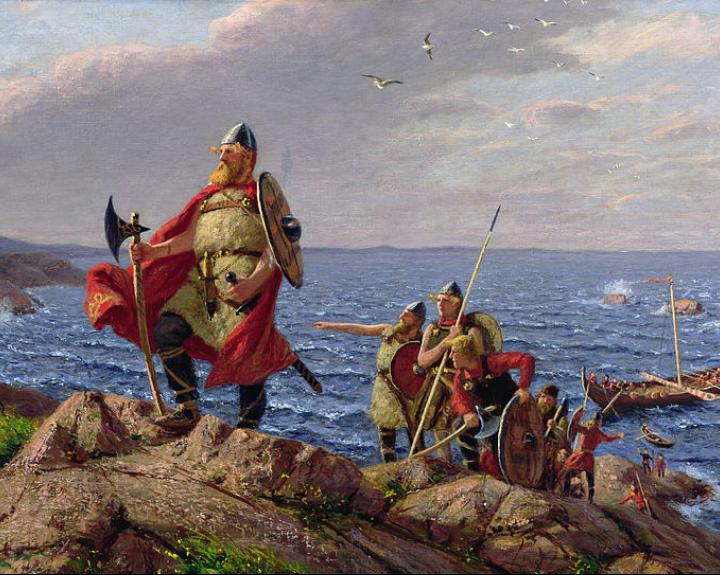
Leif Erikson, the son of legendary Viking Erik the Red, grew up to become one of the most renowned explorers of all time! Believed to be born in Iceland in the 970’s (prior to his father’s rampage and subsequent exile), he was raised in part by his ‘foster father’, a thrall called Tyrker. Leif and his siblings – Thorvald, Thorstein, and Freydis joined their pops a few years later in settling Greenland, around the year 986.
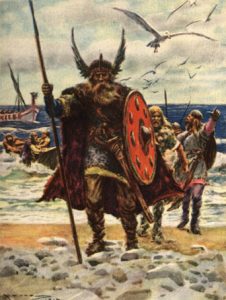
When Leif was just a boy, a man named Bjarni Herjólfsson arrived in Greenland after being blown off course. He told a tale of a vast, uncharted land, covered in fog, further west, beyond the horizon. While many were skeptical of Bjarni’s story, it inspired a sense of adventure in the young Leif.
At one point, Leif travelled to Norway and met Olaf Tryggvason aka “Olaf Crowbone” (who had a reputation for baptizing Vikings under the threat of violence), where Leif was promptly converted to Christianity. When he arrived back home in Greenland, his mother and others also converted to the hip new religion – even starting up a church, but his father was cold and distrusting of the idea. He was disappointed in his wife and son for abandoning the old ways.
Over the years, Leif kept bugging Bjarni for more information about his journey, and eventually even bought the guy’s boat from him, determined to one day set out and discover this mysterious ‘new found land’. Some Greenlanders were also keen to join him, because of their slowly dwindling supplies of timber. After gathering a crew of 35 men, they prepared for an expedition. Erik the Red was planning on joining them, but on his way to the long boat, fell off his horse, and was forced to stay behind.
Around the year 1000, Leif Erikson finally set sail on his epic journey west, into the unknown. After braving the icey waters and violent storms, the crew came upon a rocky slab of barren land, Leif called “Helluland” – which translates to “Slab Land”, known today as Baffin Island in northern Canada. They rowed further south and came across another place they dubbed “Markland” – meaning “Wood Land”… because of all the wood, I guess. (This may have been near Cape Porcupine, Labrador.)
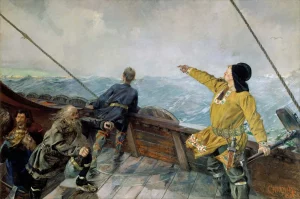
After passing by a couple other capes and islands (possibly Belle Isle and Cape Bauld), they spotted a land like nothing they’d ever seen before: a vast stretch of coastline of green meadows, mountains and forests that stretched to the horizon, and golden fields of wheat as far as the eye could see! Shortly after disembarking on the shores of this ‘undiscovered country’, Leif’s men found clusters of grape vines, great for making wine, so once again, Leif named it after the first thing that came to mind “Wine Land” or in Old Norse, “Vinland”.
Leif Erikson had just become the first European explorer to discover North America, a good 500 years BEFORE Christopher Columbus in 1492! “Vinland” (aka Canada) had verdant valleys, a mild climate, plenty of salmon and game, an infinite amount of lumber, maple trees, and even hot springs! That summer, the Vikings established a settlement – “Leifsbudir” (or ‘Leif’s Booths’), and hunkered down for the winter, before making their way back to Greenland with the good news.
Unfortunately, Leif returned home to some bad news – his father had died, leaving him in charge of Greenland. In his stead, Leif Erikson ordered a second expedition to explore the mysteries of the Great White North. The details here are a bit fuzzy, because of contradicting accounts, but most agree that this second trip was lead by his siblings, Freydis and Thorvald. This Canadian vacation however, did not go as smoothly as the first…
It turns out that *millions* of people were already living there! In fact, hundreds of indigenous tribes already populated the continent of North America, prior to the arrival of these fair-skinned, blonde-haired seafarers. The Vikings themselves however hadn’t gotten that memo – that is until they were ambushed by a group of terrifying native warriors! The Sagas referred to them as “Skrellings”, basically Dark Elves, but modern historians are pretty sure they were Native Americans from either the Mi’kmaq or Beothuk nations.
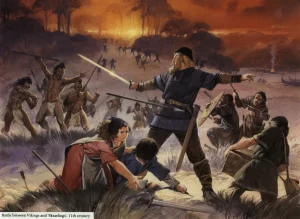
During the chaos, Thorvald (Leif’s brother) was killed by a Native’s arrow, becoming the first European to die in North America. The Norsemen panicked and fled, but Freydis (Leif’s sister), who was eight-months pregnant, stood her ground, shouting back at the cowardly men, “Why run you away from such worthless creatures, stout men that ye are […] Let me but have a weapon, I know I could fight better than any of you.” She then grabbed the sword of a fallen Viking berserker, pounded her chest at the Native Warriors, before charging at them. The Natives, not sure what to make of a pale-faced, red-haired pregnant woman lunging at them with a bloody sword, while screaming in a foreign tongue, decided to not chance it and made their retreat.
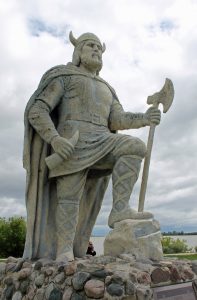
A few years later, another group of Greenlanders, led by Thorfinn Karlsefni and his wife, Gudrid (the widow of Thorstein, Leif’s other brother), attempted to colonize ‘Vinland’. It was there that Gudrid gave birth to Snorri, the first European born in America. They ended up making peace with the Natives, at least for a while, before things went south. Apparently, the Vikings traded some milk for supplies, which ended up going sour and making the Natives sick, then a Native was accused of trying to steal one of their weapons, sowing further distrust. Regardless of who started it, they were soon back at each others’ throats, leading the Vikings to eventually abandon the settlement all together.
Over the centuries, the epic sagas of Leif Erikson and his family passed into legend, but it wasn’t until 1960 that a group of Canadian researchers discovered the remnants of Viking settlements in Newfoundland, proving the stories to be true. Carbon dating confirmed that the artifacts recovered at L’Anse aux Meadows were from around the year 1020.
14. Cnut “The Great” – King of England, Denmark, and Norway
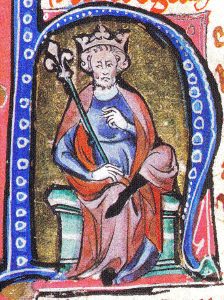
Born around 990, the son of “Sweyn Forkbeard, Son of Bluetooth”, Cnut (pronounced “Canute”) was a Danish Prince who fought alongside his father against the forces of Ethelred II (the Unready) and Thorkell the Tall in 1013. The scribes of the time figured it was worth mentioning that he had ‘fair skin’, ‘thick hair’, and “his eyes were nicer than those of other men”, so I guess we’ll just have to take their word for it.
Prince Cnut inherited the throne of England from his late father in 1014, but the English noblemen refused to accept him as King and instead voted to reinstate Ethelred the Unready – who then died abruptly in 2 years later, making Cnut the default King of England. In 1016, King Cnut was challenged by Edmund Ironside, the son of Ethelred, for the throne. The two fought a series of battles, but at the Battle of Assandun, Edmund’s ally, Eadric Streona (and his army) chickened out, fleeing the battle, handing Cnut a conveniently decisive victory. Not only that, 2 years after that in 1018, his younger brother, Harald II of Denmark also died, making Cnut the new King of Denmark as well!

Emma of Normandy – and her spoiled kids
As King of England, Cnut then spent the next several years apologizing to the Anglo-Saxons for all the previous pillaging and plundering. In order to try and appease the angry English people, Cnut decided to marry Ethelred’s widow, Emma of Normandy – the daughter of Richard, the Duke of Normandy, in 1017, and worked to make peace between the two warring countries that he’d inherited. Going so far as to convert to Christianity and even repaired all the churches and monasteries that had previously been looted or destroyed.
Cnut partitioned England into four earldoms: Northumbria, East Anglia, Mercia, and Wessex (in the south). While Cnut ruled Wessex, he temporarily gave control of Mercia to his former enemy, Eadric Streona, and East Anglia to his other former enemy, Thorkell the Tall. He then immediately set about cleaning house.
In 1017, Eadric, appeared before the King’s Court in London, on Christmas Day, where Cnut ordered Earl Eric Haakonsson to “pay this man what we owe him”. The Earl then grabbed the nearest battle axe and chopped off Eadric’s head! The man’s body was thrown over the city wall, left unburied, while his head was “placed upon a pole on the highest battlement of the Tower of London.” After that, Cnut drove Edmund Ironside’s sons out of England, and even planned the murder of his brother, just to be sure. Finally, in 1021, he even banished Thorkell the Tall – although they later made up in 1023, Thorkell mysteriously disappears from history after that.
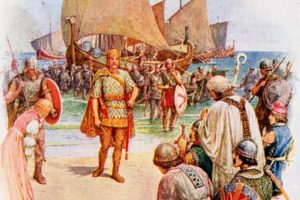
In 1028, Cnut set sail from England with a fleet of 50 ships and conquered Norway with ease! (After paying off King Olaf’s nobles, of course.) Around that same time, he also journeyed to Rome and met with the Pope who recognized him as the first Viking to become a Christian King. At one point, Cnut even made peace with Malcolm II of Scotland (after first attacking him, of course). Cnut “The Great” died suddenly on November 12th, 1035, leaving a power vacuum in three different kingdoms across Europe…
15. William the Conqueror!
William, son of Robert “The Devil” (and his mistress Herleva), was the great-great-great-grandson of Rollo the Dane, the first “French” Viking ruler (see above).
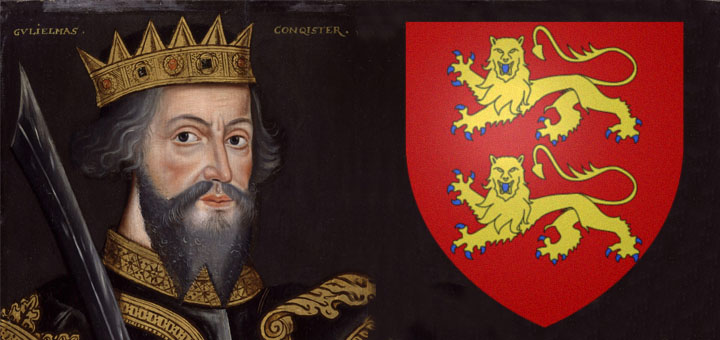
Born in 1028, Will became the Duke of Normandy at the age of 7, when his father died overseas in Jerusalem, in 1035. Throughout his childhood, he was constantly surrounded by schemes and in-fighting as the Norman aristocracy vied for power and control within his court, with many challenging his rule because he was conceived out of wedlock. In 1047, at just 19, “William the Bastard” took charge, joined forces with King Henry the First (of France), and started crushing rebellions left and right, until people stopped messing with him.
William married Matilda Flanders, the daughter of Count Baldwin V of Flanders, around 1049, despite the Pope throwing a tantrum about it. Around this time, Henry I started to get nervous with William consolidating power in the north, so decided to turn the tables and led an army into Normandy in 1054, but was quickly defeated. Henry tried invading again in 1057, and was once again chased away by William’s superior tactics. When Henry the First died in 1060, Henry’s son Philip was named the new King of France at age 7. Since Philip the First was too young to rule on his own, Count Baldwin V was named as his regent – William’s father-in-law. This gave William the opportunity to focus on expanding his reign, instead of worrying about defending his borders.
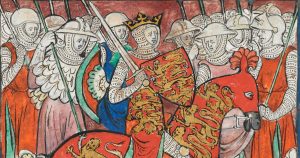
Meanwhile, across the English Channel, a political crisis was brewing…
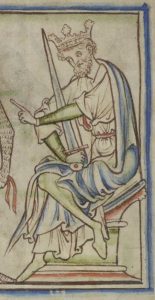
After the death of Cnut “the Great”, in 1035, his (illegitimate) son Harold “Harefoot” usurped the English crown from his half-brother, Harthacanute, while he was busy fighting overseas in Denmark. Harold died just weeks before Harthacanute arrived to take back the throne in 1040, as the ‘rightful heir’. The new King of England then had his brother’s body dug up, beheaded, and thrown in the Thames. Less then two years later, in 1042, at age 24, the newly crowned King died unexpectedly while giving a toast at a wedding!
Since the sons of Cnut had both died without producing an heir, the crown fell to Ethelred the Unready’s other son (Edmund Ironside’s brother), “Edward the Confessor” (not to be confused with his uncle, ‘Edward the Martyr’). Edward was deeply religious (as his name implies) and focused his energies on rebuilding Westminster Abbey, while letting his closest advisor, Godwin, Earl of Wessex, run the day-to-day governance. Just 8 days after construction wrapped up on the Abbey, Edward died, childless, in 1066…
Once again, the throne was up for grabs, and this time, three contenders threw their hats into the ring: 1) William of Normandy – descendant of Rollo the Dane, 2) Harald III of Norway aka Harald Hardrada, and 3) the son of Godwin, Earl of Wessex – a regular dude named Harold. A council of English nobles went with the only non-Viking option: Harold, crowning him as Harold the Second, despite having no royal blood whatsoever.

King Harold II
William was outraged, seeing this as an insult to his honor. William was a relative of Edward the Confessor (first cousin, once removed), and claimed that he’d even promised him the throne years earlier. The thought of some nobody taking the crown from him, was unacceptable, so he immediately began readying for war.

To further complicate matters, King Harold’s brother, Tostig (the Earl of Northumbria) had reached out to Harald the Third in Norway, swearing allegiance to him, for some reason. Harald Hardrada (which either means ‘hard ruler’, or ‘hair beautiful’), was the son of ‘Saint Olaf’, and (after being exiled by Cnut’s forces) had spent time with the Kievan Rus, in the court of Grand Prince Yaroslav the Wise, but eventually returned to take back the Norwegian thrown from his nephew, ‘Magnus the Good’. Although he had failed to conquer Denmark, his ferociousness in battle earned him the title “Thunderbolt of the North”! So he too jumped at the opportunity to invade England.
Harold II was crowned King of England on January 6th, 1066, and was immediately facing enemies on two fronts. King Harold began by assembling troops on the Isle of Wight, awaiting the first invasion fleet. Several months later, on September 8th, 1066, provisions were running out, so Harold disbanded the army and made their way back to London. As luck would have it, that same day, Hardrada arrived with 300 longships and 10,000 troops!
Hardrada and his Viking army raided the English coast, defeating the Anglo-Saxon forces of Northumbria and Mercia at the Battle of Fulford, near York, on the 20th of September. Hardrada and Tostig (the King’s traitorous brother) were caught by surprise by a massive Saxon army on September 25th, near Yorkshire. Before what would be known as the Battle of Stamford Bridge, a single rider approached and spoke directly to Tostig, offering the return of his earldom if he would turn against Hardrada. Tostig asked what the King would be willing to give Hardrada for his troubles. The anonymous rider replied, “Seven feet of English ground, as he is taller than other men.” After the mysterious rider rode off, Hardrada was impressed by his boldness and asked who he was. Tostig replied, “My brother”. King Harold’s army then proceeded to wipe the floor with them, neither Tostig or Hardrada survived.

Meanwhile in Normandy, Duke William and his army set sail with for England, with as many as 700 ships, on September 12th, 1066. After getting lost at sea and losing several ships in a few harsh storms, they were forced to head back to France. They tried again on September 27th, this time making it to East Sussex, with 7,000 Norman troops, ready for battle. King Harold and his army were still recovering from their previous battle when they were alerted that William’s forces had arrived in the south. Instead of waiting for the Normans to come to him, Harold II (emboldened by his recent victory), decided to intercept them. Harold’s army marched 240 miles in an attempt to catch William off guard, but the Duke’s scouts gave him a heads up.
The Battle of Hastings broke out around 9 AM on October 14th, 1066, and is considered one of the most brutal and pivotal battles in European history. The fighting reportedly went on for NINE HOURS straight! Although both armies were equally matched in numbers, Harold only had foot soldiers, while William brought the cavalry! The Saxons made a defiant last stand on Senlac Hill, forming a shield wall against a barrage of arrows, but everything quickly went down hill when Harold was killed after taking an arrow to the eye! Harold’s body was identified by his armor, the following day, among a field of corpses, left unburied on the battlefield. Harold’s mom begged William for her son’s body, offering his weight in gold, but William the Bastard refused, ordering that his body be flung into the sea.
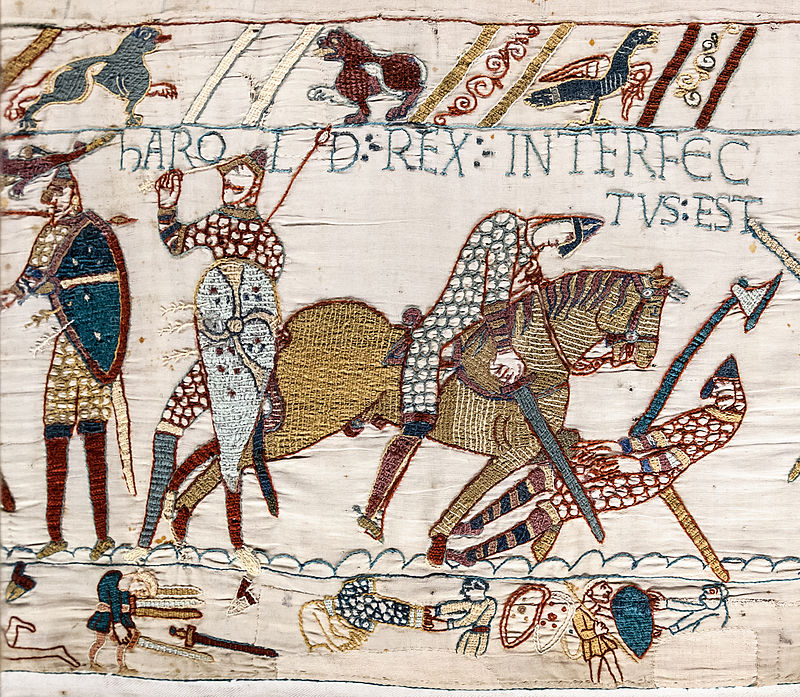
The Death of Harold II at the Battle of Hastings
William hoped that would be the end of it, but it turns out, the English weren’t too happy with this random French Viking dude riding up on horseback, killing their newly elected ruler, and then calling himself their new boss. The English nominated another guy named Edgar as their new King, but William ignored them, instead conquering every town he came across (Dover, Kent, Canterbury, Winchester, etc) – burning down any and all villages that resisted, until he crossed the Thames into London by late November. By early December, everyone had heard the rumors and decided to bend the knee to their new Norman King.

William ‘the Conqueror’ was crowned at Westminster Abbey on Christmas Day, 1066. As King, William I commanded a number of construction projects across the country: castles, moats, keeps, and even the Tower of London. He later died, after injuring himself on his saddle, during a battle in France, in 1087. The Normans would rule England (with a series of terrible rulers) until 1154, when the first Plantagenet King, Henry II – the father of Richard the Lionheart and Prince John – rose to power.
William the Conqueror’s ultimate victory over England in 1066 is often considered the end of the Viking era that began centuries earlier, in 793. In that time, the Norsemen explored far away lands, raiding their way across the world, settling in some of the harshest environments on the planet, and ultimately conquered Europe.
– Erik Slader
For more on Leif Erikson and the Viking’s discovery of North America, check out my fourth ‘Epic Fails’ book, “The Age of Exploration: Totally Getting Lost”!

Sources:

“Guts and Glory: The Vikings” by Ben Thompson
National Geographic: Vikings (March 2017)
https://www.visitnorway.com/things-to-do/art-culture/vikings/
https://www.historic-uk.com/HistoryUK/KingsQueensofBritain/
https://www.laphamsquarterly.org/roundtable/egil-mean
https://www.thevintagenews.com/2016/11/01/rollo-the-viking-who-became-the-first-ruler-of-normandy/
https://www.thecollector.com/olga-of-kiev-russian-saint-or-queen/
https://en.wikipedia.org/wiki/Egill_Skallagr%C3%ADmsson
https://www.britannica.com/biography/Erik-the-Red
https://www.englishmonarchs.co.uk/vikings_2.htm
https://en.wikipedia.org/wiki/Sweyn_Forkbeard
https://curioushistorian.com/who-was-ethelred-and-why-was-he-unready
https://en.wikipedia.org/wiki/Leif_Erikson
https://en.wikipedia.org/wiki/William_the_Conqueror
https://www.dailymail.co.uk/sciencetech/article-2593468/Murderous-tyrant-William-Conquerors-fearsome-reputation-result-ACCOUNTANCY-error-claims-historian.html

